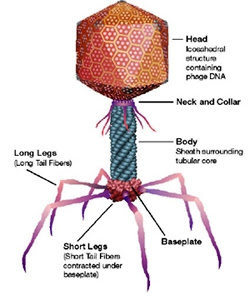1. Viruses are
a)
obligate parasites
b) free living
c) both free living and parasitic
d) none of these
2. A fully formed
infectious viral particle is called as
a)
viroid
b) virusoid
c) virion
d)
capsid
3. The genetic material
of viruses consists of either
a)
DNA
b) RNA
c) DNA or RNA
d) ss DNA or ss RNA
4. The protein coat
of virus is called as
a)
nucleid
b) capsid
c) capsomere
d)
outer envelope
5. Which of the
following is the largest virus
a)
herpes virus
b) arbovirus
c) mumps virus
d)
pox virus
6. Tobacco mosaic
virus is
a)
spherical shaped
b) rod shaped
c) cuboidal
d)
oval shaped
7. The virus with the
smallest genome
a)
circovirus
b) mimivirus
c) herpes virus
d)
rabies virus
8. The functions of
capsid include
a)
protect genetic material from nuclease attack
b) attachment and injection of viral genome into the host
c) determines the antigenic specificity of virus
d)
All of the above
9. The spike like
projections seen on the outer surface of enveloped viruses are called
a)
capsomeres
b) peplomers
c) proteomeres
d)
viroid
10. Viruses that
attacks bacteria are called
a)
Lysophage
b) bacteriophage
c) virophage
d)
none of these
11. T2 phage is a
a)
ds DNA phage
b) ss DNA phage
c) ss RNA phage
d)
ds RNA phage
12. Viral genome
attached to the bacterial genome is termed as
a)
prophage
b) lysogeny
c) lytic cycle
d)
virulent phages
13. TMV is a
a)
DNA virus
b) RNA virus
c) ss DNA or ds DNA
d)
bacteriophage
a)
temperate phages
b) virulent phages
c) lysogenic phages
d)
viroids
15. Infectious RNA
particles without protein coat
a)
viroid
b) virion
c) virusoid
d) prion
Answers:
1-a
|
2-c
|
3-c
|
4-b
|
5-d
|
6-b
|
7-a
|
8-d
|
9-b
|
10-b
|
11-a
|
12-a
|
13-b
|
14-b
|
15-a
|
